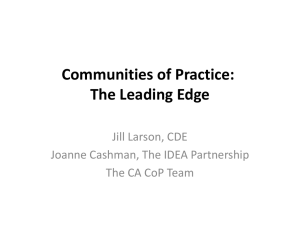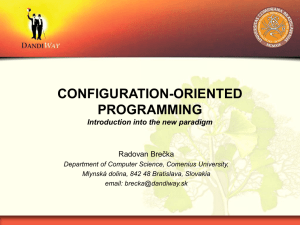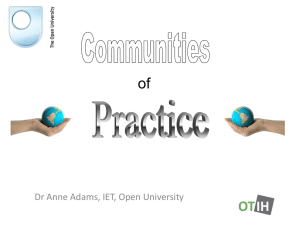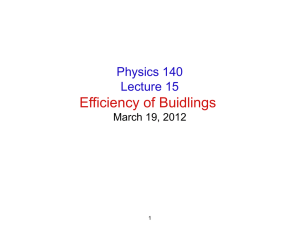Good Cop, Bad Cop: The Roles of Authority and
advertisement
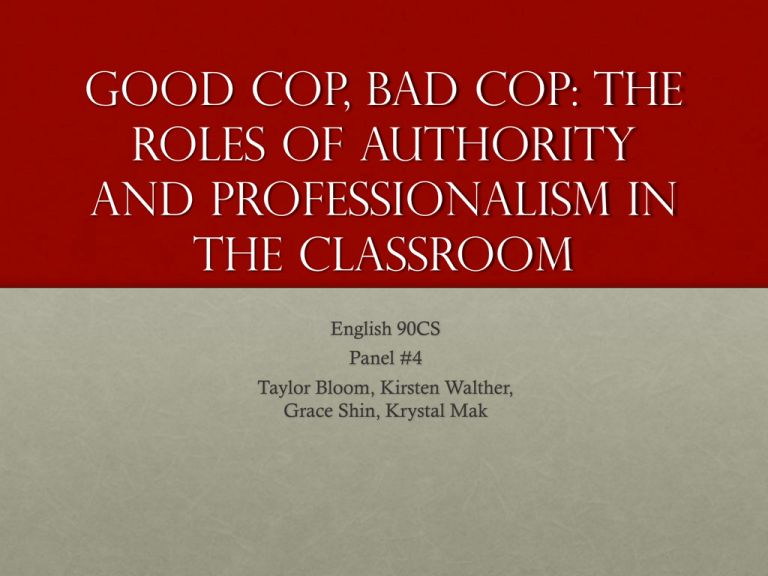
Good Cop, Bad Cop: The Roles of Authority and Professionalism in the Classroom English 90CS Panel #4 Taylor Bloom, Kirsten Walther, Grace Shin, Krystal Mak Good Cop, Bad Cop • The Pink Panther (2006): Good Cop, Bad Cop Google Images: “Strict Teacher” Google Images: “Friendly Teacher” Fastwrite • Reflect on the second fastwrite of the semester—to describe a teacher who was significant in your life. Would that teacher fall into the “strict” category, the “friendly” category, or a balance of the two? Real-Life Situation • After having reflected upon the definitions and connotations of “strict” and “friendly” teaching styles, discuss the appropriate levels of authority and friendship within the classroom, stemming from your own experiences. The Importance of Maintaining a Balance • Journal of Educational Psychology findings • Both are necessary: • Strict • To maintain equality in giving grades • To gain respect and maintain authority over students • Friendly • To make students feel respected and understood Compare and contrast • Consider Miss Rain in Push, Mr. Wicher in Push, Amy in The Writing Class, and Mr. Keating in Dead Poet’s Society • What types of power do the teachers exert? • Are they successful? • Why or why not? Complicating factors… Complicating Factors • Socioeconomic status • Teacher’s age • Gender relations • Student behavior/willingness to learn • Teacher’s appearance Complicating Factors: Socioeconomic Status • Lack of access to proper educational resources • Inherently low expectations (administration, community) • More at-risk for delinquency, teen pregnancy, etc. • Lack the proper academic home environment • How does this change the appropriate teaching style? Complicating Factors: Teacher’s Age • Younger teachers • More authoritative • Compensate for lack of experience • Older teachers • Less authoritative • Authority based on respect/trust • How does this change the appropriate teaching style? Complicating Factors: Teacher’s Age cont’d. • Samba et al. 2003 • Study of 160 science teachers at a secondary school in Benue state, Nigeria • Measure the rate of utilization of 19 different teaching strategies • Conclusions: • “gap that could be created by age and experience” • Older, more experienced teachers: higher utilization of teaching strategies such as discussions, demonstrations, problem solving, etc. • Younger, less experienced teachers: lower rate of utilization Complicating Factors: Gender Relations • Paper centers on the importance of a professor establishing authority according to the gender of students • Different motives behind using certain methods, such as being very strict or repressing emotion in the classroom • To what extent should a teacher employ both tough and soft love in the classroom? • STANDARDS OF EVALUATION • NOT AN EITHER/OR SITUATION Complicating Factors: Student Behavior/Willingness to Learn • Student is unwilling to learn • How does this change the appropriate teaching style? Complicating Factors: Teacher’s Appearance • Teachers come in a variety of shapes, forms, and sizes; though the ideal would be for a student to be open to all of these forms, this is not always the case—at least initially. • First impressions count • Up the Down Staircase • Freedom Writers • First impressions are just that—eventually the substance will either support or counter these impressions

